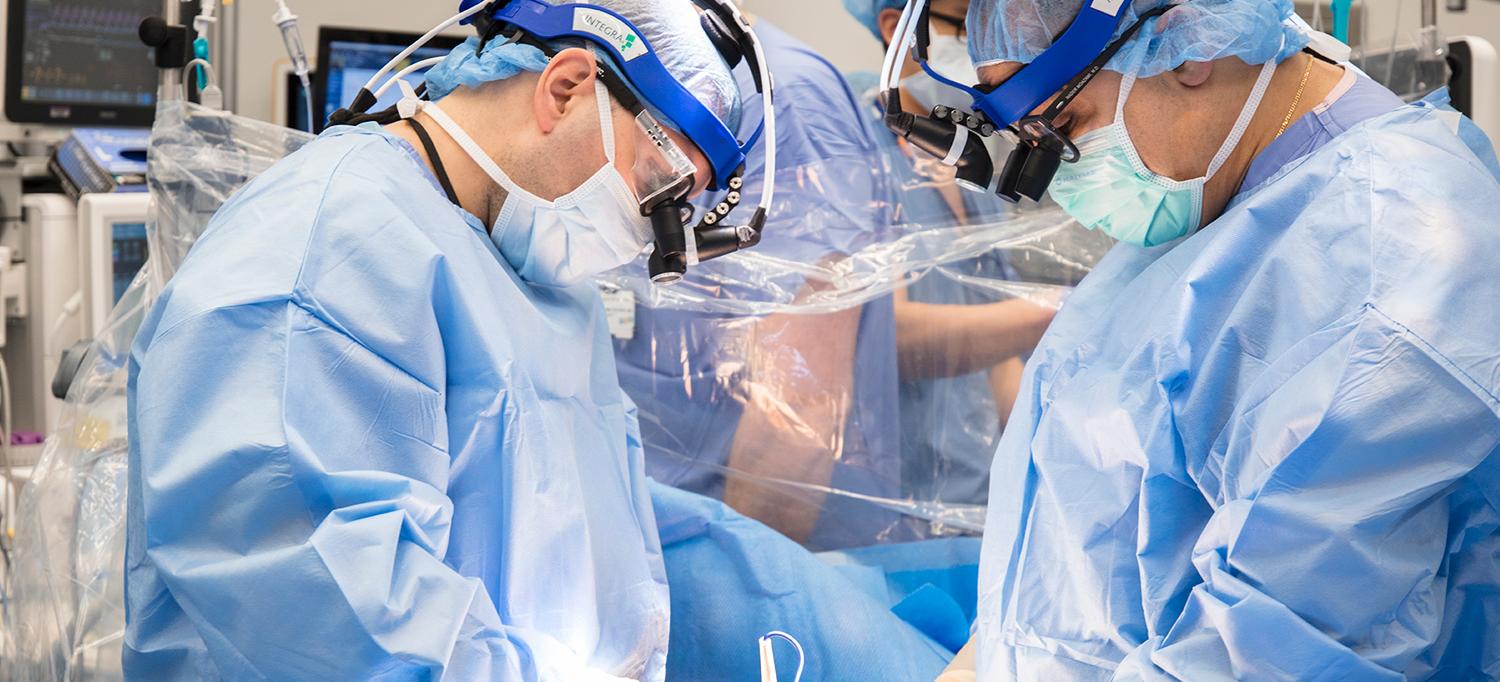
NYU Langone Transplant Institute experts, including Dr. Nader Moazami and Dr. Deane E. Smith, perform a combined heart–lung transplant with a novel approach.
Photo: NYU Langone Staff
With other treatment options exhausted for a patient with end-stage idiopathic pulmonary arterial hypertension and right ventricular failure, a multidisciplinary team from the NYU Langone Transplant Institute recommended a donation after circulatory death (DCD) heart–lung transplant to expedite her lifesaving surgery. Following careful surgical planning supported by the institute’s innovative DCD viability research, the patient underwent successful transplantation with a positive outcome that shows promise for other patients awaiting donor organs.
Compounding Clinical Picture Precludes Typical Wait for Transplant
The 53-year-old woman presented for combined heart–lung transplantation—a complicated surgical procedure that may provide the only opportunity for survival with a return to normal quality of life for a subset of patients with end-stage cardiac and pulmonary disease. Unfortunately, due to the patient’s status on the United Network for Organ Sharing (UNOS) list, she was unlikely to obtain donor organs from that network.
“We are one of the few institutions in the country to perform combined heart–lung transplants,” explains Nader Moazami, MD, chief of the Division of Heart and Lung Transplant and Mechanical Circulatory Support, and surgical director of heart transplantation at the Transplant Institute. “Unfortunately, the procedure is rarely performed as a result of the scarcity of organs from donation after brain death (DBD), which results in untenable delays for patients waiting for a suitable donor.”
To address the scarcity of available organs, the Transplant Institute continuously explores new strategies to expand the donor pool, working closely with procurement agencies and aggressively searching for new sources, providing patients with shorter waits and reductions in the waitlist mortality associated with prolonged hospital stays and associated complications. The DCD approach utilizes organs obtained from a donor after life support is withdrawn and the heart has stopped; the patient has not been declared brain dead before the withdrawal of support, in contrast to the standard DBD approach, in which brain death must first be declared. At the time of this patient’s presentation, the method had recently resurfaced as the subject of an interventional pilot study by transplant surgeons at the institute.
Novel Approach Expands Organ Pool and Offers New Hope for Survival
DCD heart donation involves a technique called normothermic regional perfusion (NRP), which resuscitates the heart in the donor once life support has been withdrawn according to the patient’s or family’s wishes. When it is confirmed that the heart has stopped and circulatory death is declared, cardiopulmonary bypass is used to resuscitate the heart and re-establish blood flow to the entire body except the brain. “This unique method corrects the metabolic abnormalities that occur with death, and also allows comprehensive evaluation of cardiac function to determine if the heart is suitable for transplant,” explains Dr. Moazami.
In January of 2020, transplant surgeons at NYU Langone launched their study, Heart Transplantation Using Normothermic Regional Perfusion Donation After Circulatory Death, to examine the method’s efficacy. “The use of normothermic regional perfusion in situ with an assessment of myocardial function has shown comparable outcomes between DCD and DBD hearts as a result of shortened ischemic time,” notes Dr. Moazami. “To further reduce ischemic time, we place the donor and recipient in adjacent operating rooms.”
With 250,000 Americans diagnosed with end-stage heart failure in the United States, up to 15 percent of them urgently in need of transplant, surgeons at the Transplant Institute realized that the expansion of the donor pool with DCD donor hearts could significantly reduce the growing backlog of patients with end-stage heart disease awaiting transplantation—offering hope to patients without other treatment options. DCD heart transplant using regional normothermic perfusion provides an opportunity to expand the pool of available donor hearts for transplant by up to 20 percent.
As the patient’s cardiorespiratory failure continued to progress rapidly in June of 2020, the transplant team realized that she was unlikely to receive donor organs in time from the typical pool. DCD organs, however, are counted outside of that UNOS network. “For this patient, a DCD donor heart could be assigned just in time, since we are the only center in the United States using this approach,”says Dr. Moazami. After identification of a suitable donor from the NRP–DCD study, surgeons planned the details of the procedure.
Careful Planning and Surgical Precision Put Patient on Path to Recovery
The complexity of the case necessitated collaboration among surgeons, intensivists, and cardiologists. In addition to Dr. Moazami, the team included Deane E. Smith, MD, assistant professor of cardiothoracic surgery and associate director of heart transplant and mechanical circulatory support; Zachary Kon, MD, formerly an assistant professor in the Department of Cardiothoracic Surgery; Stephanie H. Chang, MD, assistant professor in the Department of Cardiothoracic Surgery and surgical director of lung transplantation; Julius A. Carillo, MD, clinical assistant professor in the Department of Cardiothoracic Surgery; Luis F. Angel, MD, professor in the Departments of Medicine and Cardiothoracic Surgery and medical director of lung transplantation; Alex Reyentovich MD, associate professor in the Department of Medicine, medical director of the heart transplant and left ventricular assist device programs and clinical director of the heart failure program; and Claudia G. Gidea MD, associate professor in the Department of Medicine and associate director of the ventricular assist device and heart transplant. “Without this amazing team of specialists lending their knowledge, experience, and dedication across every step of this process, we would not be able to perform this pioneering procedure,” says Dr. Gidea.
The patient agreed to proceed with transplantation after a discussion of the potential risks. After the establishment of donor circulatory arrest and a five-minute standoff time, the donor median sternotomy was performed, and the cerebral blood vessels were ligated before cannulation of the aorta and right atrium and initiation of standard cardiopulmonary bypass. The functional quality of the allograft quality was confirmed by intraoperative transesophageal echocardiogram and right heart catheterization after thirty minutes. Combined heart and lung transplantation was performed without any major complications. The patient was discharged to Rusk Rehabilitation and returned home six weeks after admission.
Close Collaboration and Shared Expertise Led to Optimal Outcome
At the time of follow-up three months post-transplant, the patient complained of a dry cough but was otherwise doing well. Transthoracic echocardiogram revealed normal ventricular size and wall motion with left ventricular ejection fraction of 65 percent. Right heart catheterization revealed excellent cardiac output and normal pulmonary artery and right atrial pressures.
For this patient, the Transplant Institute’s position at the forefront of innovative approaches to meet the demand for available organs—combined with focused multidisciplinary transplant expertise—delivered a successful intervention when time was running out. “Seamless integration of specialized care and an advanced, rarely utilized approach enabled our team to address the patient’s uniquely urgent needs with a pioneering transplant,” notes Dr. Chang.
“In this case, a successful outcome depended fully on our ability to innovate for the sake of our patients,” Dr. Moazami adds. “Without this program, the patient would not have been transplanted. Now, we can offer the possibility of transplant to patients who otherwise are unlikely to receive organs through the UNOS network.”
The NYU Langone Transplant Institute team includes surgeons, heart failure cardiologists, nephrologists, pulmonologists, endocrinologists, hepatologists, infectious disease experts, radiologists, and rehabilitation specialists, in addition to dedicated pharmacists, social workers, nutritionists, and nurses and nurse practitioners with specialized training in transplantation. Leadership in clinical research and a search for new treatment strategies coupled with surgical expertise and cutting-edge technology has made NYU Langone Transplant Institute one of the nation’s top transplant institutes.
In January 2021, for the second report in a row, NYU Langone's heart transplantation program has been ranked No. 1 in the nation by the Scientific Registry of Transplant Recipients. Since 2019, NYU Langone has achieved the shortest wait times in the Northeast with the best outcomes for heart transplantation, and has the highest survival rate for heart–lung transplantation.

